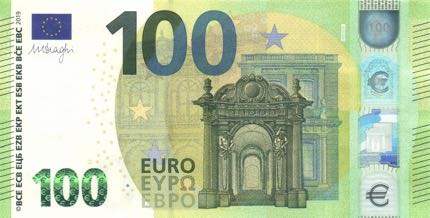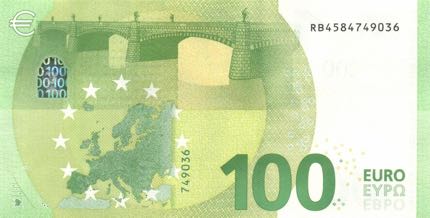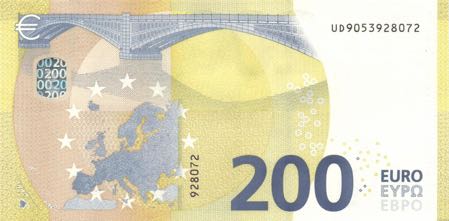European Monetary Union
European Monetary Union new signature 100-euro note (B105n3) confirmed
14 09, 2019 08:38 Category: Europe
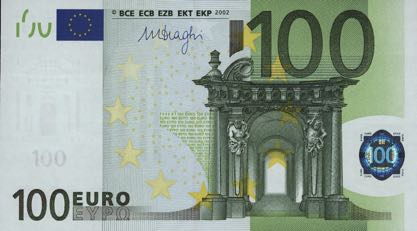
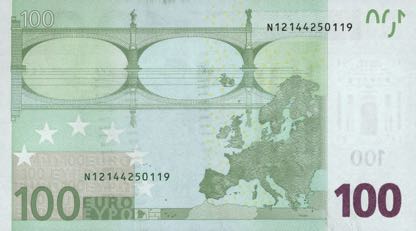
Like B105n2, but new signature (Draghi).
Courtesy of Mikhail Plakhov.
European Monetary Union nominates Christine Lagarde as next president
02 07, 2019 13:24 Category: Europe
According to a CNBC article dated 2 July 2019, Christine Lagarde, managing director of the International Monetary Fund, has been nominated to become the next president of the European Central Bank, succeeding Mario Draghi if approved.
Courtesy of Dennis Zammit.
Courtesy of Dennis Zammit.
European Monetary Union new 100- and 200-euro notes (B112, B113) confirmed introduced 28.05.2019
30 05, 2019 09:02 Category: Europe
European Monetary Union unveils new 100- and 200-euro notes (B112, B113) scheduled for 28.05.2019 introduction
17 09, 2018 10:11 Category: Europe
On 17 September 2018, the European Central Bank unveiled the new 100- and 200-euro notes scheduled to be introduced on 28 May 2019, thereby completing the Europa series. The new notes feature a satellite hologram and an enhanced OVI “emerald number” with € symbols at lower left front. They are also a different size than the preceding issues.
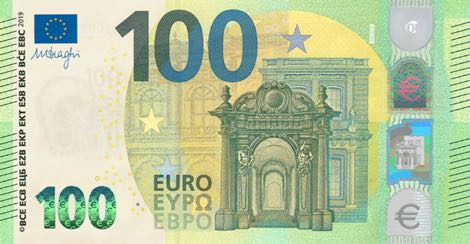
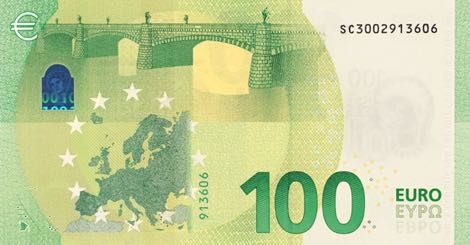
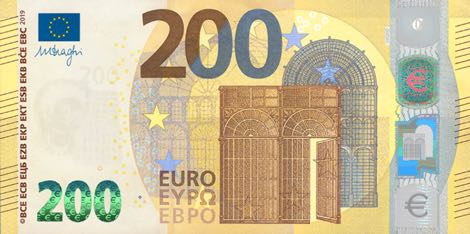
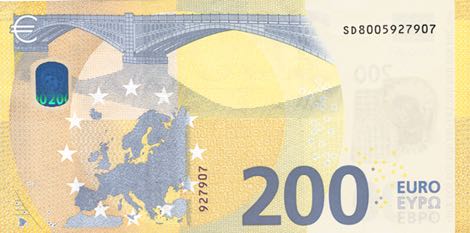
Courtesy of Dennis Zammit.




Courtesy of Dennis Zammit.
Ireland may stop printing euro banknotes
14 03, 2018 09:50 Category: Europe
According to an RTE article dated 9 March 2018, the board of the Central Bank of Ireland is considering a recommendation to stop printing euro banknotes at the bank's Currency Centre in Sandyford, Co Dublin. Ireland would continue to use euro banknotes printed elsewhere.
Courtesy of Jim Chen.
Courtesy of Jim Chen.
European Monetary Union new 50-euro note (B111) confirmed
04 04, 2017 08:42 Category: Europe
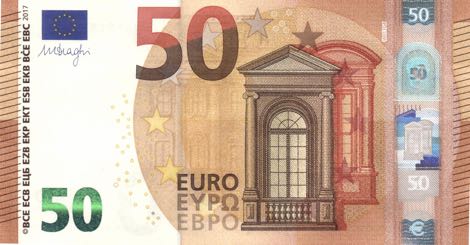

B111 (P23): 50 euro (US$55)
Orange. Front: Flag; Renaissance architecture. Back: Bridge; map. Holographic stripe. Solid security thread with demetalized 50 EURO. Watermark: Head of Europa and electrotype 50. Printer: Various (see code chart). 140 x 77 mm.
w3. Signature 3. Prefix PB, WB. Intro: 04.04.2017.
Courtesy of Hartmut Fraunhoffer (Banknote-Online).
European Monetary Union new 50-euro note (B111) unveiled
05 07, 2016 07:13 Category: Europe
On 5 July 2016, the European Central Bank unveiled the design of the new 50-euro note due to be introduced into circulation on 4 April 2017. This is the fourth denomination in the new Europa series.

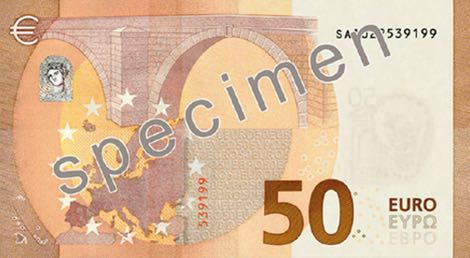


European Central Bank to unveil new 50-euro note on 05.07.2016
17 06, 2016 11:48 Category: Europe
According to a press release dated 16 June 2016, the European Central Bank plans to unveil the new Europa series 50-euro banknote on 5 July 2016, with introduction into circulation in the first half of 2017.
European Central Bank to retire 500-euro note (B107) in 2018
04 05, 2016 11:42 Category: Europe
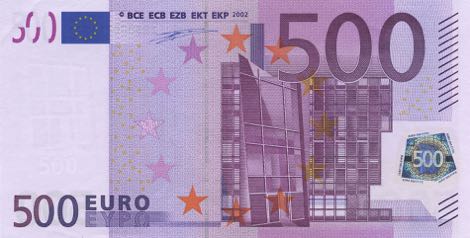

According to a press release dated 4 May 2016, the European Central Bank will discontinue production and issuance of the 500-euro banknote (B107) in 2018, though existing notes will remain legal tender. The new Europa series will not include the 500-euro denomination.
Courtesy of Christof Zellweger.
European Monetary Union 20-euro note (B110) confirmed
28 11, 2015 14:53 Category: Europe

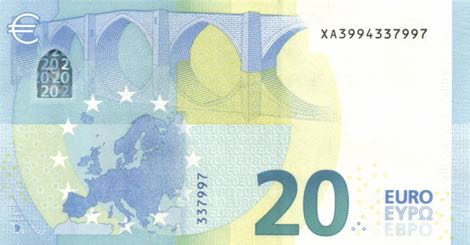
B110 (PNL): 20 euro (US$22)
Blue. Front: Flag; Gothic architecture. Back: Bridge; map. Holographic stripe. Solid security thread with demetalized 20 EURO. Watermark: Head of Europa and electrotype 20. Printer: Various (see code chart). 133 x 72 mm.
Signature 3. Prefix E, M, N, R, S, U, W, X confirmed. Intro: 25.11.2015.
Courtesy of Hartmut Fraunhoffer (Banknote-Online).
European Monetary Union new 20-euro note (B110) reportedly introduced 25.11.2015
25 11, 2015 10:56 Category: Europe
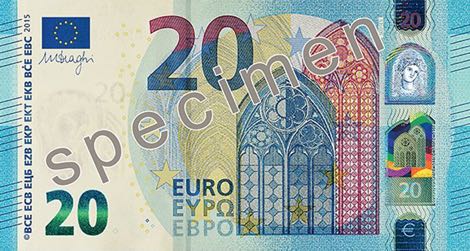
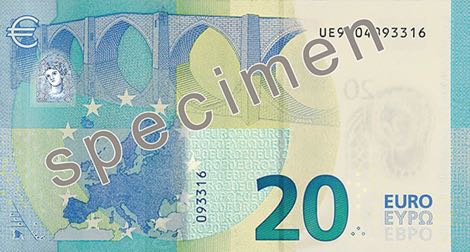
According to a press release, the new 20-euro note was introduced on 25 November 2015. "The new €20, the third in the Europa series, enters into circulation today. It has a refreshed look and more vibrant colours, and includes a new kind of security feature: a “portrait window” near the top of the hologram stripe which becomes transparent when seen against the light. The window reveals a portrait of Europa, a figure from Greek mythology, which is visible on both sides of the note. The same portrait is also visible in the watermark, alongside an emerald number which displays an effect of the light moving up and down when the note is tilted – exactly like in the €5 and €10 of the Europa series."
How do you change a currency – fast?
06 07, 2015 14:53 Category: Europe
"How do you change a currency – fast?" by Isabelle Fraser was posted on The Telegraph on 30 June 2015. It's an excellent article drawing on De La Rue's experience replacing Iraq's currency and provides other great historical examples of how to handle the possible departure of Greece from the European Monetary Union.
Courtesy of James Cadman.
Courtesy of James Cadman.
European Monetary Union new 5-euro with prefix Y (Greece)
04 06, 2015 10:22 Category: Europe

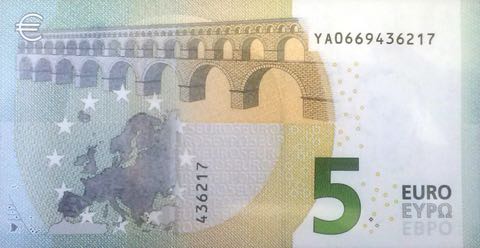
5 euros, 2013. Like ECB B8, but prefix Y (Greece).
Courtesy of Takis Kouvatseas.
European Monetary Union new 20-euro note to be issued 25.11.2015
24 02, 2015 08:48 Category: Europe

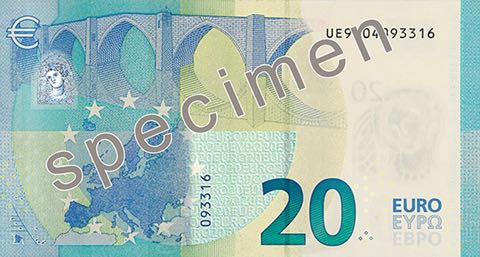
On 24 February 2015, Mario Draghi, president of the European Central Bank, unveiled the new 20-euro banknote in Frankfurt. The new note will be introduced 25 November 2015.
The new note includes an innovative security feature in the form of a “portrait window” set in the hologram. When the banknote is held against the light, the window becomes transparent and reveals a portrait of the mythological figure Europa, visible on both sides of the note. The new €20 banknote, like the new €5 and €10 notes, also includes an “emerald number” and a portrait of Europa in the watermark.
Courtesy of Michel Daspre.
European Monetary Union to unveil new 20-euro note on 24.02.2015
22 12, 2014 21:36 Category: Europe
According to a press release dated 19 December 2014, on 24 February 2015 the European Central Bank will unveil the new Europa series 20-euro note design with improved security features.
Courtesy of Cleo Phas.
Courtesy of Cleo Phas.
European Monetary Union new 10-euro note confirmed
23 09, 2014 21:46 Category: Europe
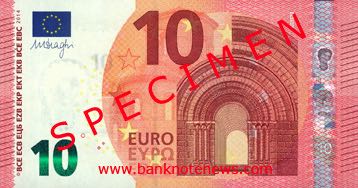
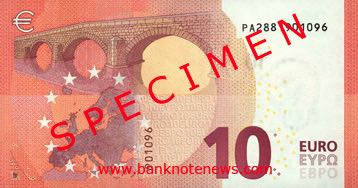
ECB B9 (PNL): 10 euros (US$14)
Red. Front: Flag; Romanesque architecture. Back: Bridge; map. Holographic stripe. Solid security thread with demetalized 10 EURO. Watermark: Head of Europa and electrotype 10. Printer: Various (see code chart). 127 x 67 mm. Confirmed with prefix E, N, P, S, U, V, X, Y, all with signature 3.
Courtesy of Don Ludwig and The Currency Exchange.
European Monetary Union new signature 50-euro note with prefix E (Slovakia)
21 07, 2014 09:21 Category: Europe
50 euros, 2002. Like ECB B4, but new signature (Mario Draghi) and prefix E (Slovakia).
Courtesy of Peter Lorenc.
Courtesy of Peter Lorenc.
European Monetary Union new signature 50-euro note with prefix G (Cyprus)
21 07, 2014 09:18 Category: Europe
50 euros, 2002. Like ECB B4, but new signature (Mario Draghi) and prefix G (Cyprus).
Courtesy of Peter Lorenc.
Courtesy of Peter Lorenc.
European Monetary Union new signature 500-euro note with prefix N (Austria)
21 07, 2014 09:16 Category: Europe
500 euros, 2002. Like ECB B7, but new signature (Mario Draghi) and prefix N (Austria).
Courtesy of Peter Lorenc.
Courtesy of Peter Lorenc.
European Monetary Union new signature 50-euro note confirmed for Slovenia
12 06, 2014 05:58 Category: Europe
50 euros, 2002. Like ECB B4, but new signature (Draghi) and country code H (Slovenia).
Courtesy of Sev Onyshkevych.
Courtesy of Sev Onyshkevych.
Lithuania may adopt euro in 2015
05 06, 2014 09:18 Category: Europe
On 4 June 2014, the European Commission released its 2014 Convergence Report, which assesses eight Member States’ readiness to join the single currency. The commission proposed that the EU Council of Ministers decide that Lithuania can adopt the euro on 1 January 2015. The council will take the final decision on the matter in the second half of July, after EU Heads of State and Government have discussed the subject at the 26-27 June European Council, and after the European Parliament has given its opinion.
Courtesy of Jim "Rubycored" Chen.
Courtesy of Jim "Rubycored" Chen.
European Monetary Union new 10-euro note unveiled
13 01, 2014 22:10 Category: Europe


On 13 January 2014 the European Central Bank unveiled the new 10-euro note to be issued 23 September 2014.
Latvia to adopt euro on 1 Janaury 2014
26 12, 2013 10:40 Category: Europe
According to Latvijas Banka, Latvia will join the European Monetary Union on 1 January 2014 when it switches from the lat to the euro.
Courtesy of Brian Lema.
Courtesy of Brian Lema.
European Central Bank to unveil new 10-euro note 13.01.2014
26 11, 2013 12:32 Category: Europe
According to a press release dated 26 November 2013, the European Central Bank will unveil its new Europa series 10-euro note on 13 January 2014 and issue the note later in the year.
Courtesy of Aidan Work.
Courtesy of Aidan Work.
European Monetary Union new 10-euro note to be introduced in 2014
22 10, 2013 07:54 Category: Europe
The European Central Bank intends to introduce a new 10-euro note in 2014. No images of or information about the new note are available at this time.
Courtesy of Aidan Work.
Courtesy of Aidan Work.
European Monetary Union new 5-euro note confirmed
02 05, 2013 08:02 Category: Europe
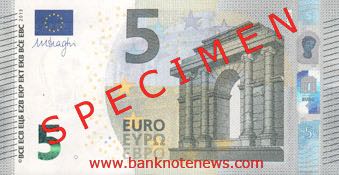
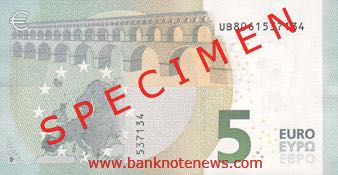
5 euros, 2013. Intro: 02.05.2013. These notes have two-character prefixes and it's not yet clear if they use the same country codes as the preceding series. Prefixes confirmed to date include UB and VA.
Courtesy of Richard Castello (www.castedos.com or http://stores.ebay.com/CastedosInvestments) and Hartmut Fraunhoffer (www.banknoten.de).
European Monetary Union new sig 20-euro note confirmed
10 03, 2013 09:14 Category: Europe
20 euros, 2002. Like ECB B3 (P3 & P10), but new signature (Mario Draghi), country code X, and printer code E008F5.
Courtesy of Edwin Biersteker.
Courtesy of Edwin Biersteker.
European Monetary Union chapter of The Banknote Book is now available
14 02, 2013 13:12 Category: The Banknote Book | Europe

The European Monetary Union chapter of The Banknote Book is now available for individual sale and as a free download to subscribers.
This 8-page catalog covers notes issued by the European Central Bank from 2002 to present. Revised 5 July 2016.
Each chapter of The Banknote Book includes detailed descriptions and background information, full-color images, and accurate valuations. The Banknote Book also features:
- Sharp color images of note’s front and back without overlap
- Face value or date of demonetization if no longer legal tender
- Specific identification of all vignette elements
- Security features described in full
- Printer imprint reproduced exactly as on note
- Each date/signature variety assigned an individual letter
- Variety checkboxes for tracking your collection and want list
- Red stars highlight the many notes missing from the SCWPM
- Date reproduced exactly as on note
- Precise date of introduction noted when known
- Replacement note information
- Signature tables, often with names and terms of service
- Background information for historical and cultural context
- Details magnified to distinguish between note varieties
- Bibliographic sources listed for further research
Subscribe to The Banknote Book
If you collect the entire world or a large number of countries, buying a subscription is the best deal because it's less expensive than buying chapters individually, and it entitles you to every chapter currently available as well as everything published—or revised (click here to see the Change Log)—during the term of your subscription.

Sign up for Email Notifications
If you would like to receive email notifications whenever a new chapter of The Banknote Book is published, please join the email list by clicking the button below.

European Monetary Union new signature variety 100-euro note confirmed
24 01, 2013 14:37 Category: Europe

100 euros, no date. Like P5, but new signature (Mario Draghi).
Courtesy of Márk Döme.
European Central Bank unveils new 5-euro note due 02.05.2013
10 01, 2013 10:58 Category: Europe
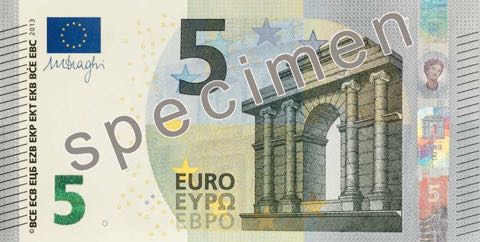

10 January 2013 - Eurosystem unveils the Europa series €5 banknote
Mario Draghi, President of the European Central Bank (ECB), today unveiled the Europa series €5 banknote. The unveiling was the highlight of the opening of the “New Face of the Euro” exhibition, which is being held at the Archaeological Museum in Frankfurt am Main from 11 January to 10 March 2013.
The new €5 banknote has benefited from advances in banknote technology since the first series was introduced over ten years ago. It includes some new and enhanced security features. The watermark and hologram display a portrait of Europa, a figure from Greek mythology – and hence the name of this series of banknotes. An eye-catching “emerald number” changes colour from emerald green to deep blue and displays an effect of the light that moves up and down. Short raised lines on the left and right edges of the banknote make it easier to identify the banknote, especially for visually impaired people.
These security features are planned to be included in all the new banknotes. They are easy to check using the “feel, look and tilt” method.
The new series has the same “ages and styles” design and dominant colours as the first series. The €5 will be the first banknote to be issued, starting on 2 May 2013. The other denominations, i.e. €10, €20, €50, €100, €200 and €500, will be introduced over the next few years, in ascending order.
The first series will initially circulate alongside the new banknotes, but will gradually be withdrawn and eventually cease to be legal tender. The date when this occurs will be announced well in advance. However, the banknotes of the first series will retain their value indefinitely and can be exchanged at euro area national central banks at any time.
European Monetary Union to issue new "Europa" series 5-euro note in May 2013
08 11, 2012 09:10 Category: Europe
According to a press release dated 8 November 2012, "The European Central Bank (ECB) and the national central banks (NCBs) of the Eurosystem are to introduce a second series of euro banknotes. Called the “Europa” series, it will include a portrait of Europa – a figure from Greek mythology and the origin of the name of our continent – in the watermark and the hologram. The new banknotes will be introduced gradually over several years, starting with the €5 banknote in May 2013.
The Europa series has benefited from advances in banknote technology since the first series was introduced over ten years ago. Its security features have been enhanced, which will help to make the banknotes even more secure. Three new features – the portrait watermark, portrait hologram and emerald number – have been unveiled today.
The new banknotes are an evolution. Like the first series, they will have the “ages and styles” design and the same dominant colours, but they have been modified to accommodate the enhanced security features. They will be easy to distinguish from the first series. The Europa series will have the same denominations as its predecessor, i.e. €5, €10, €20, €50, €100, €200 and €500, and they will be introduced in ascending order. Thus, the new €10 banknote will follow the €5.
The first series will initially circulate alongside the new banknotes, but will gradually be withdrawn and eventually cease to be legal tender. The date when this occurs will be announced well in advance. However, the banknotes of the first series will retain their value indefinitely and can be exchanged at the Eurosystem NCBs at any time.
The Europa series €5 banknote will be unveiled in full on 10 January 2013 and credit institutions will start to issue the new notes over the counter or via cash dispensers in May next year.
In order to raise public awareness of the Europa series, the ECB and the NCBs of the Eurosystem will be conducting a multi-channel information campaign across the euro area in 2013. Preparations are currently under way, supported by two agencies chosen by the ECB following a public tender."
Courtesy of Ricardo Castedo, J. M. Peso, Alex Zlotin, and José Luis Arrayás.
European Monetary Union to issue new notes in 2013
07 11, 2012 09:59 Category: Europe
According to an article on EUObserver dated 5 November 2012, "The European Central Bank is Thursday to present a plan for replacing current euro notes with safer ones from [May] 2013, Hessischer Rundfunk reported Sunday. The second generation euro notes will still have values from five to €500, but motifs will change and improved security features will make forgery more difficult."
Courtesy of José Luis Arrayás.
Courtesy of José Luis Arrayás.
European Central Bank rumored to use Europa design on new notes
01 09, 2012 14:11 Category: Europe
According to an article on Bloomberg dated 31 August 2012, the European Central Bank is said to be using an image of Europa from Greek mythology on its new euro banknotes due to be unveiled in November and issued starting in May 2013.
Courtesy of Lars Kersten and Mehdi Kasumov.
Courtesy of Lars Kersten and Mehdi Kasumov.
Euro notes with new security features expected in 2013
24 08, 2012 09:43 Category: Europe
According to an article in Standart News dated 24 August 2012, the European Central Bank is set to issue new euro banknotes with enhanced security features at the beginning of 2013. More details are expected this autumn.
European Monetary Union new signature 10-euro note confirmed
09 07, 2012 16:14 Category: Europe

10 euros (US$12), 2002. Like P2, but new signature (Mario Draghi). Confirmed with X country code for Germany and P printer code for G&D. Also reported X for Germany and E for Oberthur, as well as T for Ireland and K for Central Bank of Ireland.
Courtesy of Merjim Groen and Peter Mosselberger.
European Monetary Union banknotes with new signature (Draghi) confirmed
10 04, 2012 18:56 Category: Europe

According to an artilce on Focus dated 18 March 2012, the European Central Bank has begun circulating banknotes with the signature of Mario Draghi, who has served as ECB president since 1 November 2011, following Jean-Claude Trichet and Willem Duisenberg. All other features of the euro notes remain the same, including the copyright date.
Courtesy of Richard Miranda and Claudio Marana.
European Central Bank gets new governor on 01.11.2011
31 10, 2011 12:13 Category: Europe

As of 1 November 2011, Mario Draghi takes over from Jean-Claude Trichet as governor of the European Central Bank. Draghi previously served as the head of the Bank of Italy since 29 December 2005. The change in governors will likely be followed by new signature varieties of euro banknotes.
Courtesy of Dennis Zammit.
European Monetary Union 50-euro note oddity reported
20 05, 2011 15:05 Category: Europe
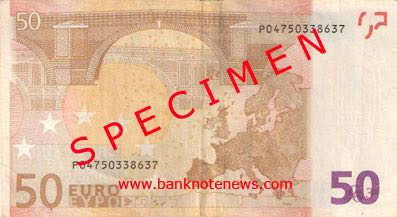
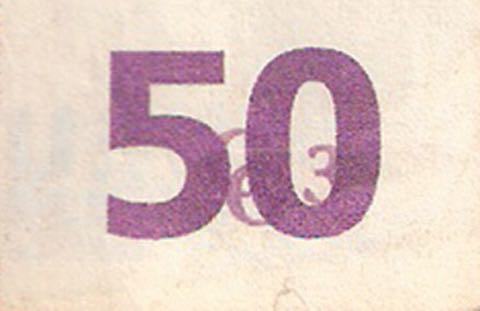
Does anyone have any information about this 50-euro (Pick 4) note which appears to have CC3 printed near the 50 denomination in the lower right rear? The person reporting this note says it appears the CC3 was printed at the same time as the rest of the note, not as an overprint, but it’s hard to confirm based upon the scans provided. In any event, if you’ve seen other such notes or have any ideas on how/why it was created and what it’s worth, please post a comment.
UPDATE: Thomas Krause recommends this web site which shows hundreds of different stamps applied to euro notes.
Euro notes contain rare earth elements for luminescence
17 05, 2011 17:47 Category: Europe
According to an article on SmarterScience, euro banknotes use a rare earth element known as europium to enhance the luminescence of anti-counterfeiting features.
Courtesy of Richard Bonkowski.
Courtesy of Richard Bonkowski.
Estonia adopts euro on 01.01.2011
31 12, 2010 08:35 Category: Europe
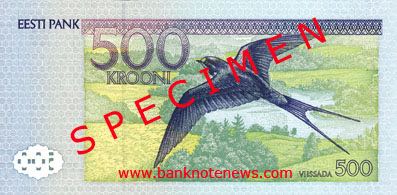
Like the barn swallow on the back of one of my favorite Estonian banknotes shown above, the kroon will fly away on 1 January 2011 as Estonia joins 16 other countries which have traded their own individual currencies for the common euro. Kroon, we’ll miss you!
European Monetary Union to introduce 2nd-generation euro notes as early as 2013
01 10, 2010 12:51 Category: Europe
According to an article in Wiener Zeitung, the second generation of euro notes is slated for introduction in 2013 or 2014. The new notes will be designed by the same Austrian designer, Robert Kalina, and retain their basic color schemes, but security will be enhanced.
Courtesy of Ricardo Castedo.
Courtesy of Ricardo Castedo.
Estonia to adopt euro in 2011
08 06, 2010 13:25 Category: Europe
According to a Bloomberg article dated 8 June 2010, European finance ministers backed Estonia’s bid to become the 17th country using the euro starting 1 January 2011. Time to start looking for kroon notes to fill the holes in your collections!
Courtesy of Stein Langørgen.
Courtesy of Stein Langørgen.
